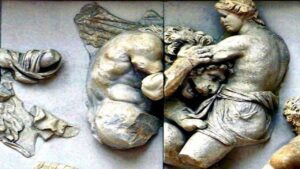Table of Contents
In the realm of mythical creatures, few captivate the human imagination quite like the enigmatic Sirena. These alluring, aquatic beings are a staple in folklore across cultures worldwide. Sirena, also known as sirens in Greek mythology, represents a blend of beauty, danger, and mystique that has fueled countless stories, artistic expressions, and symbolisms throughout history.
Origin and Cultural Significance

Sirena’s origins trace back to ancient Greece, where they were first introduced in Homer’s epic poem, the “Odyssey.” Moreover, in Homer’s tale, Sirens were portrayed as seductive, bird-like creatures whose enchanting songs lured sailors to their doom on rocky shores. This portrayal of Sirens as alluring and perilous beings, indeed, set the stage for their enduring symbolism.
Additionally, the name “Sirena” itself is derived from the Greek word “seirēn,” which is believed to have originated from “seira” (rope) or “seirios” (hot, scorching). This possibly signifies their power to enthrall and ensnare sailors. Over time, furthermore, the concept of Sirena evolved, becoming not just harbingers of destruction but also symbols of femininity, sensuality, and the deep, mysterious depths of the ocean.
Appearance and Abilities
In terms of appearance and abilities, Sirena is typically depicted as a beautiful, half-woman, half-fish creature. Their upper body resembles that of an alluring human woman, complete with captivating features, while their lower half transforms into a fish’s tail, elegantly colored and shimmering with aquatic splendor. This captivating combination of human and fish characteristics is meticulously crafted to entice and enchant those who gaze upon them.
However, Sirena’s most famous attribute lies in their mesmerizing voice. It is worth noting that their singing has a profound and almost mystical effect on those who hear it. Consequently, it is said that their singing can captivate even the most steadfast and seasoned sailors, effectively luring them into treacherous waters. Moreover, their voices are often described as akin to liquid gold, an irresistible melody that beckons with promises of love and ecstasy, only to lead those who listen astray, deepening the allure of these enigmatic beings.
Symbols and Representations

Feminine Allure: Sirena embodies the allure and beauty of the feminine form. Their captivating appearance and enchanting songs symbolize the power of feminine charm and sensuality.
Danger and Temptation: Sirena serves as a warning against the allure of temptation and the perils of succumbing to desire. Their songs represent the seductive allure that can lead individuals astray, often with disastrous consequences.
The Ocean’s Mysteries: Sirena’s fish-like lower body symbolizes the mysteries and depths of the ocean. They often assume the role of guardians or protectors of the sea, embodying its beauty and danger.
Freedom and Independence: In some interpretations, Sirena represents a longing for freedom and independence. Their fish tails allow them to navigate the open waters of the ocean, free from the constraints of the land.
Transformation: The fusion of human and fish attributes in Sirena’s appearance reflects the idea of transformation and the coexistence of different elements in nature.
Myths and Stories
Sirena’s enduring presence in mythology and folklore has led to a plethora of stories and adaptations across cultures. Here are some notable tales involving Sirena:
The Odyssey
In Homer’s epic poem “The Odyssey,” the encounter with the Sirens is a pivotal moment in Odysseus’s arduous journey back home after the Trojan War. The Sirens’ allure is so potent that they pose a grave threat to his return. To resist their irresistible song, Odysseus devises a clever strategy. He has his crew plug their ears with beeswax, rendering them deaf to the Sirens’ enchanting melodies. However, Odysseus, driven by an insatiable curiosity, chooses a different path. He orders his crew to tie him to the mast of his ship so that he can hear the Sirens’ song without being able to act on his desires. This act of self-restraint underscores the theme of temptation and the resilience of the human spirit against alluring but destructive forces. It also illustrates the power of curiosity, showing that even the wisest of heroes can be susceptible to the Sirens’ mystique.
The Little Mermaid
Hans Christian Andersen’s “The Little Mermaid” explores the poignant story of a young mermaid princess who dreams of becoming human to be with her beloved prince. This beloved fairy tale touches on themes of unrequited love, self-sacrifice, and the longing for transformation. The Little Mermaid’s sacrifice is profound; she trades her melodious voice for legs, enduring immense pain with every step she takes on land. This act of sacrifice underscores the notion of giving up a fundamental part of oneself for the pursuit of love and a dream. The story delves into the complexities of desire and the sacrifices we may make to attain our heart’s deepest desires, all while weaving a narrative that continues to resonate with readers of all ages.
Merrow
In Irish folklore, the Merrow, or “Muireann,” are mermaids with a distinct cultural twist. Unlike the seductive Sirens, people often depict Merrow as benevolent beings. These Irish mermaids possess a magical red cap called a “cohuleen druith,” which grants them the ability to live on land as humans. The presence of the cohuleen druith symbolizes the duality of identity—the idea that one can exist in two worlds simultaneously. This theme of dual existence speaks to the universal human experience of navigating multiple roles and identities in life. The Merrow’s red cap is a powerful symbol, signifying the delicate balance between embracing one’s true self and adapting to the demands of the external world.
The Harpies
In Greek mythology, people often mention the Harpies in the same breath as the Sirens because of their shared bird-like features and their capacity for mischief. Moreover, the Harpies, portrayed as winged creatures with women’s faces, have a reputation for their disruptive actions. These actions include stealing food from those who crossed their path and tormenting individuals they encountered. Their actions symbolize chaos and disorder in the natural world. The Harpies serve as a stark contrast to the enchanting yet destructive allure of the Sirens. While both creatures embody aspects of the unknown and the untamed, the Harpies evoke fear and disorder, whereas the Sirens evoke desire and temptation. This dichotomy highlights the multifaceted nature of mythological beings and their ability to embody a range of symbolic meanings.
Cultural Impact and Thematic Exploration
Sirena’s enduring appeal lies in its ability to explore complex and universal themes. Among these themes, one can find the dichotomy of beauty and danger, the allure of the unknown, the power of temptation, and the ever-present human desire for transformation and freedom.
Furthermore, throughout history, Sirena has left an indelible mark on literature, art, and popular culture. As a result, they have inspired countless works of art, ranging from classical sculptures and paintings to contemporary novels and films. In the realm of music, the term “siren song” is often used metaphorically to describe any irresistible and seductive appeal.
Sirena’s symbolism has also found its way into feminist discourse. Some interpret Sirena as a symbol of feminine empowerment, representing women’s agency and the ability to assert their desires in a world that may seek to suppress them.
In the vast tapestry of mythical creatures and beings, Sirena stands as an enduring and captivating figure. Their origins in Greek mythology have given rise to a rich and complex set of symbolisms, stories, and interpretations that continue to fascinate and inspire people to this day. Sirena’s unique blend of beauty, danger, and mystique serves as a reminder of the eternal human fascination with the unknown and the seductive power of the imagination. Sirena’s presence in our cultural lexicon, whether as enchanting temptresses or guardians of the deep, stands as a testament to the enduring power of myth and storytelling.
FAQ
What do Sirens look like?
Sirens are typically portrayed as half-woman, half-bird or half-fish beings. Their appearance can vary in different legends, but they are generally depicted as alluring and seductive.
What is the legend of the Sirens?
According to Greek mythology, the Sirens were originally nymphs who were transformed into creatures with beautiful voices by the goddess Demeter. They were known for luring sailors to shipwreck on their island with their irresistible singing.
How did sailors protect themselves from Sirens?
In mythology, sailors used various methods to protect themselves from the allure of Sirens. These included blocking their ears with beeswax or being tied to the ship's mast to resist the temptation.
What is the significance of Sirens in literature and art?
Sirens have been a popular subject in literature, art, and music for centuries. They often symbolize temptation, the dangers of the unknown, and the allure of beauty.
Are Sirens only found in Greek mythology?
While Sirens are most famously associated with Greek mythology, similar creatures with seductive and dangerous qualities exist in other mythologies and cultures worldwide, such as mermaids in folklore.
Do Sirens have any positive attributes in mythology?
In some variations of the myth, Sirens were believed to possess knowledge and could prophesize. However, their primary association remains with luring sailors to their demise.
Are Sirens a real-life phenomenon?
No, Sirens are purely mythical creatures and do not exist in the real world. They remain a fascinating and enduring part of human storytelling and imagination.




